Crayon sculptures
These crayon sculptures by Hoang Tran are amazing.
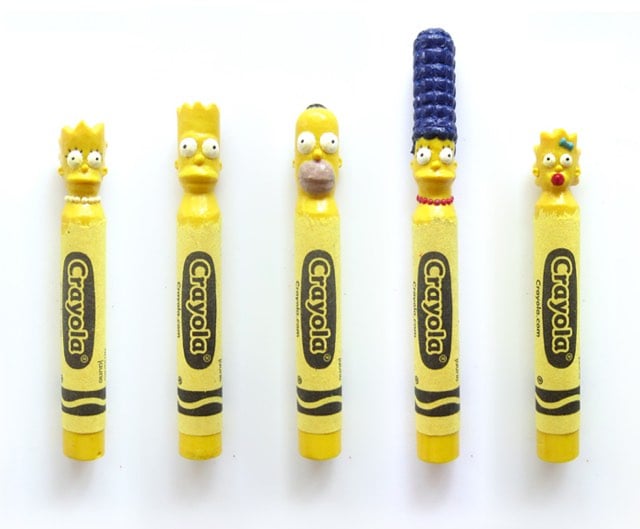


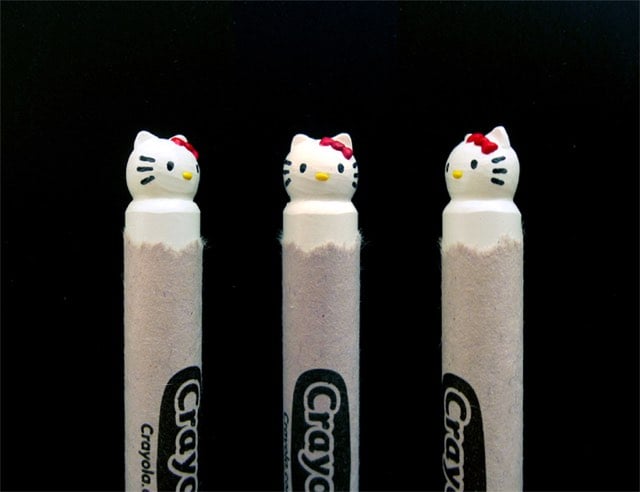

Select sculptures are available on Etsy. (via ignant)



This site is made possible by member support. 💞
Big thanks to Arcustech for hosting the site and offering amazing tech support.
When you buy through links on kottke.org, I may earn an affiliate commission. Thanks for supporting the site!
kottke.org. home of fine hypertext products since 1998.
These crayon sculptures by Hoang Tran are amazing.





Select sculptures are available on Etsy. (via ignant)
On Reddit, a fan of The Simpsons recently outlined his theory that Homer Simpson has been in a coma for the past 20 years and everything on the show since mid-1993 has taken place in Homer’s head. Here’s the argument…
In the series’ first clip show, which aired in the fourth season, Bart pranks Homer by shaking up his beer can in a paint shaker. The beer explodes and knocks Homer into a coma. At the end of the episode, Homer is shown waking up from the coma. But maybe he didn’t? As possible evidence, the theorist suggests that’s why the Simpsons never age:
This is why the characters don’t age. Homer remembers Bart, Lisa, and Maggie as 10, 8, and 1 year old, so they will always appear that way in his dreams. He is subconsciously aware of time passing, so his mind will often “update” his memories so that the year they occurred matches up with the age he thinks he is.
And it’s also why the plots on the show became more outlandish after the coma episode:
This is clearly Homer’s imagination running wild. With no real world restrictions, Homer’s mind is able to dream up scenarios of him and his family in fantasies involving him winning a Grammy, his father fighting his boss for buried WW2 treasure, his wife getting breast implants, his infant daughter saving him from drowning, etc.
That’s pretty clever. It immediately reminded me of two things:
1. The entirety of St. Elsewhere took place inside the mind of an autistic kid named Tommy Westphall. And since St. Elsewhere was referenced on other TV shows like Homicide: Life on the Street, that means those shows (and the shows referenced on those shows) also took place in Westphall’s mind.
2. From 1991 to 1994, a show called Herman’s Head aired on Fox. The show took place partially in the main character’s head. Among the cast are two regular Simpsons cast members: Hank Azaria (Moe, Chief Wiggum, Apu, Comic Book Guy, etc.) and Yeardley Smith (Lisa). Super-crazy theory: perhaps Herman’s Head inspired Homer’s coma?
Update: Of course this theory isn’t true. Al Jean, a writer and show runner for The Simpsons during season four, told TMZ that Homer hasn’t been in a coma for the past 20 years. (thx, greg)
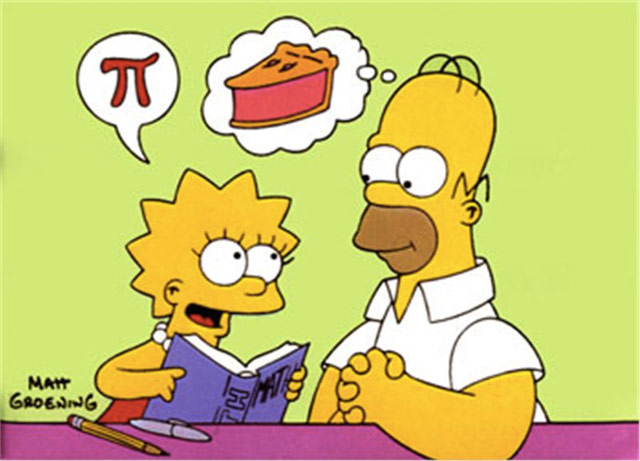
Acclaimed science and math writer Simon Singh has written a book on the mathematics of The Simpsons, The Simpsons and Their Mathematical Secrets. Boing Boing has an excerpt.
The principles of rubber sheet geometry can be extended into three dimensions, which explains the quip that a topologist is someone who cannot tell the difference between a doughnut and a coffee cup. In other words, a coffee cup has just one hole, created by the handle, and a doughnut has just one hole, in its middle. Hence, a coffee cup made of a rubbery clay could be stretched and twisted into the shape of a doughnut. This makes them homeomorphic.
By contrast, a doughnut cannot be transformed into a sphere, because a sphere lacks any holes, and no amount of stretching, squeezing, and twisting can remove the hole that is integral to a doughnut. Indeed, it is a proven mathematical theorem that a doughnut is topologically distinct from a sphere. Nevertheless, Homer’s blackboard scribbling seems to achieve the impossible, because the diagrams show the successful transformation of a doughnut into a sphere. How?
Although cutting is forbidden in topology, Homer has decided that nibbling and biting are acceptable. After all, the initial object is a doughnut, so who could resist nibbling? Taking enough nibbles out of the doughnut turns it into a banana shape, which can then be reshaped into a sphere by standard stretching, squeezing, and twisting. Mainstream topologists might not be thrilled to see one of their cherished theorems going up in smoke, but a doughnut and a sphere are identical according to Homer’s personal rules of topology. Perhaps the correct term is not homeomorphic, but rather Homermorphic.
This happened a few days ago, but I just got a chance to check it out: FXX launched Simpsons World, a site where you can stream every Simpsons episode ever aired. You just need a cable login, as with HBO GO. There are apps too: iOS and Android. To get you started, here are the top 10 episodes of all time, from a 2003 Entertainment Weekly list.
1. Last Exit to Springfield
2. Rosebud
3. Cape Feare
4. Marge vs. the Monorail
5. Homer’s Phobia
6. Mr. Plow
7. Itchy & Scratchy Land
8. A Fish Called Selma
9. Treehouse of Horror V
10. The Last Temptation of Homer
Update: Got a bunch of complaints that the “free” in the title is misleading because a cable subscription is required, even though I explicitly called that out in the second sentence. Fair enough. But then again, if you’re going to nitpick, nothing is free. Even if you didn’t need a cable login, Simpsons World would hardly be free. You need access to an expensive computer or mobile device, high-speed internet access, and enough free (there’s that word again!) time to watch. And even if you’re viewing using a computer at the public library, you’re paying with your attention by watching advertising.
But all that is red herring nonsense. I was using “free” in the sense that for cable subscribers, they’re getting something they did not have for the same price they were previously paying. You know, free.
This Lego version of the Simpsons house looks amazing. Not sure if it’s $200 amazing, but still. These minimalist Lego Simpsons characters are much cheaper.
From Mallory Ortberg at The Toast, an appreciation of Ralph Wiggum.
Ralph is not a rule-follower like Lisa, nor a rule-breaker like Bart; Ralph does not observe the rules because he is almost completely unaware of them. More than any of the other students at Springfield Elementary, Ralph is a child. Bart and Lisa and Milhouse and Nelson and Janey are kids, and therein lies the difference. Ralph sees things that aren’t there (“Ralph, remember the time you said Snagglepuss was outside?” “He was going to the bathroom!”), eats paste, picks his nose, volunteers unprompted, nonsensical declarations (“My cat’s breath smells like cat food”) disguised as Zen koans. His character is sometimes written as dim-but-profound, sometimes borderline-psychotic, and occasionally developmentally disabled, but more than anything else, Ralph like what he is: a child who hasn’t yet aged into a kid, which is one of the most embarrassing things a child can be.
Goes nicely with this video of some of Ralph’s finest moments:
Homer Economicus is a new book which uses the fictional world of Springfield on The Simpsons to explain the basic concepts of economics.
Since The Simpsons centers on the daily lives of the Simpson family and its colorful neighbors, three opening chapters focus on individual behavior and decision-making, introducing readers to the economic way of thinking about the world. Part II guides readers through six chapters on money, markets, and government. A third and final section discusses timely topics in applied microeconomics, including immigration, gambling, and health care as seen in The Simpsons. Reinforcing the nuts and bolts laid out in any principles text in an entertaining and culturally relevant way, this book is an excellent teaching resource that will also be at home on the bookshelf of an avid reader of pop economics.
(via mr)
Chris Pattle has constructed Simpsons characters completely out of CSS.
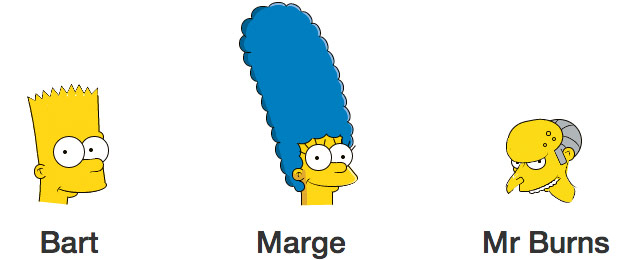
We’ve come a long way from #cccccc. And it looks like Pattle avoided the Simpson No-Nos.
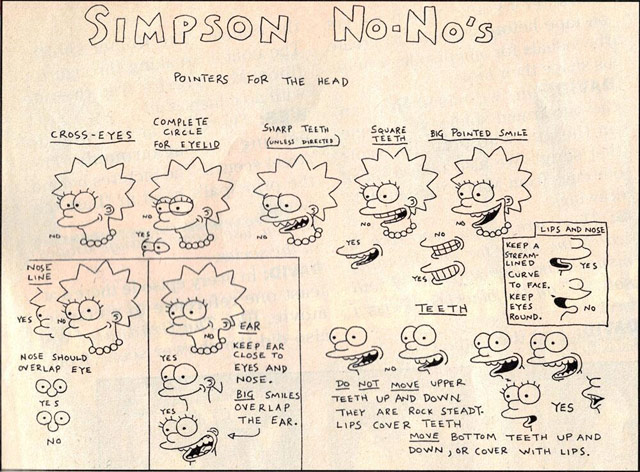
Artist JK Keller took an episode of the Simpsons, ran the entire thing through some audio and video filters, and somehow it retains the full character of the show while also seeming like, as Keller puts it, “a frenetic mess of sight and sound”.
After ripping all the frames, I used software to turn the ripped images into vectors. Then I processed the files through Illustrator using the default Alignment & Distribution tools (23 different combinations). With the audio, I used a similar process, making a spectrogram image of the audio from each cut in the episode. Then I applied a variety of processes to the image to mimic the alignment/distribution used.
There’s a blizzard bearing down on the northeastern United States and here’s some essential information you need to know if you live in an affected area:
But seriously, you should follow @EricHolthaus for the latest storm info. (Ok, so we have our first celebrity Twitter weatherman. Weather and climate are going to become a lot more important in American pop culture…at what point do Gawker or Buzzfeed launch their climate verticals?)
Update: Gawker now has a climate vertical, The Vane. (via @bgporter)
A selection of good Ralph Wiggum moments from The Simpsons.
Pretty good, except that they missed “I’m Idaho”, “This tastes like burning”, and “Oh boy, sleep! That’s where I’m a viking!” (via @erikmal)
With the Olympics about two weeks away, consider this a final you-can’t-unsee-it reminder that the 2012 London Olympics logo looks like Lisa Simpson performing oral sex.

It’s not as bad as some of the others on this list (oh, that Mon-Sat logo), but it’s still exceptionally unforgettable. Enjoy the wall-to-wall Olympic coverage for the next two weeks!
If you’ve never seen the early seasons of The Simpsons, a good way to catch up might be to watch this:
Just a quick hack to experiment what happens if you watch a lot of The Simpsons episodes at the same time. It just took 10 lines of code and a few hours of processing.
About the video:
-Top to bottom: each row shows a season (from season 1 to season 10)
-Left to right: each column shows an episode (from episode 1 to episode 13)A total of 130 episodes is displayed, framerate is 25fps, thumbnails have been captured at 80x60px
I also enjoyed this minimalist representation of the Simpson family in Lego:

(via @TrevorBaum)
Usher’s OMG sounds suspiciously close to a Christmas carol that Homer wrote in an episode of The Simpsons. Take a listen:
Here’s Bill Oakley, a former writer and showrunner for The Simpsons, on how the show got made back in the show’s golden years (seasons 4-8).
Twice a year, from at least season three ‘til season eight, there’d be these story retreats where everybody would come and present their ideas for episodes. We’d get a big conference room in a hotel about a hundred yards from the office, and we’d go around and everybody would tell their ideas, one by one. It was sort of like opening Christmas presents on Christmas morning; we’d go around in a circle and everybody would have a turn or two.
It was always a huge treat to see. You had no idea what George Meyer (for instance) was going to say, and suddenly it was like this fantastic Simpsons episode pouring out of his mouth that you never dreamed of. And it was like, wow, this is where this stuff comes from.
Oakley also provided an example of a script as it went through all of its revisions on its way to the airwaves; it’s the one where Principal Skinner gets fired and Bart tries to get him his job back.
Recently, Mat Williams hand wrote 288 of the lines Bart Simpson writes on the blackboard to open every episode. He used 20 white markers over 2 days to complete the work on the 22m long blackboard at Work Club, a London based ad agency. Clicking here will allow you to zoom in on any part of the blackboard, while clicking here will allow you to watch a video of Mat skateboarding through London and writing on the blackboard in a Bart Simpson mask.
Incidentally, there have been 463 episodes, and Bart doesn’t write on the chalk board in the opening to all of them. To read a list of all the openings, go here. To SEE a list of all the openings, go here. There’s an electrical outlet in front of Bart’s knee in every season except season 1 and season 21. This might only be interesting to me.
(via nerdcore + thedailywh.at)
After 429 episodes, The Simpsons finally get a new intro sequence…in HD and Dolby Digital 5.1 no less. (via fimoculous)
Eye On Springfield celebrates Simpsons moments from seasons 1-9, when the show was “still funny”. If you’re around me for more than a few minutes, it’s likely you’ll hear “freshen ya drink, govenah?” at some point.
Video of the Simpsons Halloween episode opening that spoofs the Mad Men intro.
In a special Halloween episode of The Simpsons that aired in October 1995, a freak lightning storm brings all of Springfield’s giant advertising statues to life. The advertising monsters begin to destroy the town when Lisa, an advertising executive, and Paul Anka come up with a jingle urging everyone to stop paying attention to the monsters. Here’s the chorus:
Just don’t look. Just don’t look.
Just don’t look. Just don’t look.
Just don’t look. Just don’t look.
The townspeople comply and with no one paying attention, the advertising monsters collapse and die, saving the town.
The “just don’t look” strategy works for more than advertising…it’s effective in any situation where someone or something runs on attention. On the web attention comes in the form of links and pageviews so “just don’t look” translates roughly into “just don’t link or read”. If you don’t like who’s on the cover of Wired, just don’t look. If no one talks about her, she’ll go away. Think media gossip sites are ruining the web? Don’t read them. Leggy blonde conservative got your knickers in a knot? Just don’t look. Commenters ruining the internet? Moderate your comments or close them up. If some Web 2.0 blowhard says something stupid, just don’t look. Hate blonde socialites? Just. Don’t. Look.
Futurama series portrait. Same deal this Simpsons one. (via vitamin briefcase)
A few drawings of characters from The Wire drawn in the style of The Simpsons. Here’s a scene from season one; D’Angelo tries to teach chess to Wallace and Bodie:
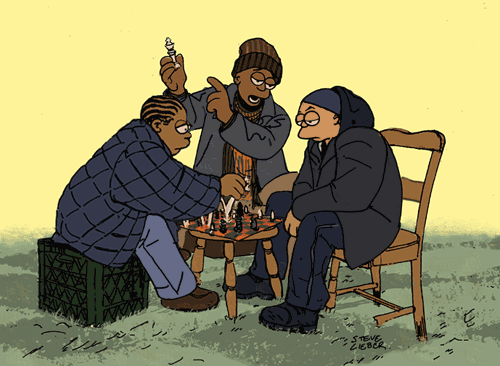
This might be my new favorite thing on the web. (thx, andy)
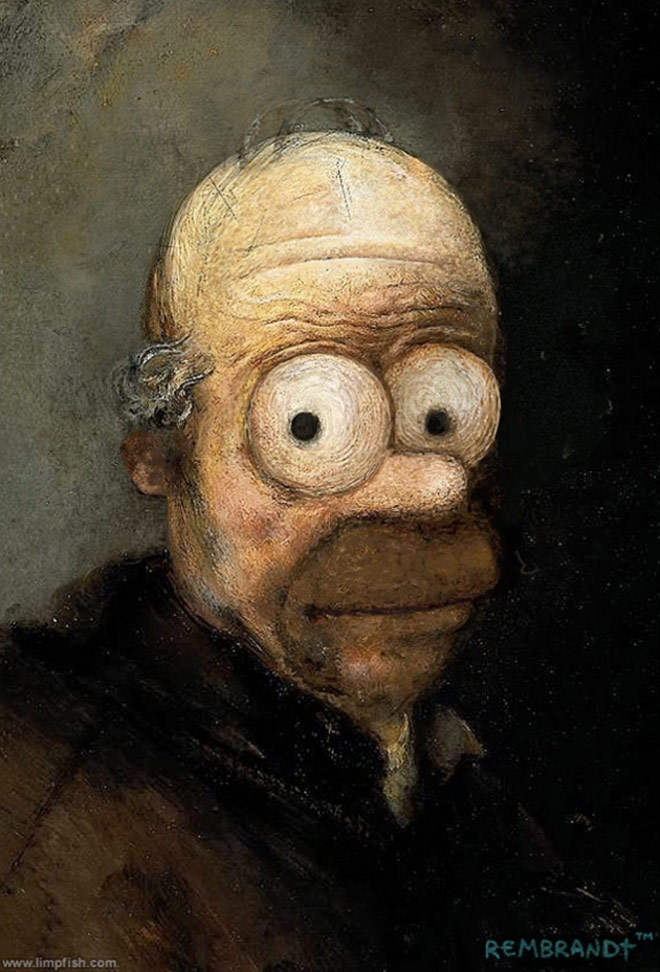
This portrait of Homer Simpson painted in the style of Rembrandt is strangely mesmerizing. Can’t look away from those giant eyes.
Wow, The Simpsons did a parody of Noah Kalina’s Everyday video. Noah, you just graduated summa cum laude from Pop Culture University.
Update: But apparently the background music was used without permission.
A few months back a producer from the Simpsons contacted Carly about using her song ‘everyday’ for an upcoming episode in which they were going to parody my video. She was negotiating a rate for the song, until they never got back to her. No fee was agreed on, no contracts signed.
Maybe they decided since it was parody they didn’t need permission? I don’t find that likely since what little I know about Hollywood/TV is that they’re really concerned about clearing rights. (thx, slava)
Update: The song rights mixup was an accidental oversight and is currently being corrected.
Dozens of stills from The Simpsons that make references to famous scenes in movies.
Photos of a 7-11 set up as a Kwik-E-Mart to promote the Simpsons Movie. (thx, jon)
Embiggen, the fauxcabulary word created for an episode of The Simpsons, has found its way into string theory. Here’s the usage from a recently published paper on Gauge/gravity duality and meta-stable dynamical supersymmetry breaking:
Here’s the original quote from The Simpsons episode, Lisa the Iconoclast:
A noble spirit embiggens the smallest man.
The uses are probably not related, but you never know.
Stay Connected